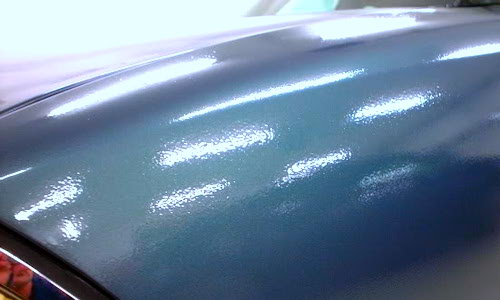How To
What causes the "orange peel" finish when spraying?
The orange peel effect is an uneven finish that can happen due to several factors
Last updated on 17 Oct, 2025
Orange peel is often the result of the painting technique, or some technical reasons related to air pressure or paint viscosity. It can be caused by the quick evaporation of thinner, incorrect spray gun setup (such as low air pressure or using the incorrect nozzle), spraying the paint at an angle other than perpendicular, or applying excessive paint.

The "orange peel" effect (see above image) looks uneven, with a wrinkled finish like the texture of an orange.
When it comes to aerosol spray painting, you don't have control over a couple of these things, namely, paint viscosity and nozzle size. Your ScratchesHappen aerosol can was filled with the correct viscosity paint, and the can contains the correct reducer and propellant combination, and air pressure, to properly atomize the paint. The nozzle on the can has been tested to properly atomize the paint.
However, there are a few variables that you can control. One is temperature. If you spray at a cold temperature, the pressure in the can will be reduced, and that can cause the paint to not properly atomize. Make sure the air temperature is at least 70 degrees F. If it is colder, you can raise the temperature of the can by filling a pot with hot tap water, and immersing the can partially in the water to get the temperature higher. Don't boil the water...normal hot water from the tap mixed with cold water to a temperature that your hand can stand is adequate for this. Too much heat and it risks exploding the can. So proceed carefully if you try this. This is a good discussion on how to warm a can up
The other variable is your application technique. Applying the paint too heavy, or spraying at an angle that is not perpendicular to the body panel can result in orange peel. Our paint is best sprayed in several thin coats, instead of heavy coats. Practice this on a test card or test panel to see how your technique affects the final finish. With a little practice, you can eliminate the dreaded orange peel finish!
How to Fix Orange Peel
Note: if you are reading this article because you have some orange peel in your newly painted finish, it can be corrected. You will have to dry sand the orange peel area with 500-1000 grit paper until the orange peel is smoothed out, and then re-apply the base color using the techniques above. If the orange peel effect is severe, then you may need to move to an even lower grit paper to prevent the paper from clogging up with the clear coat that is being sanded off. A 200-300 grit paper should be low enough to level the orange peel effect, however at this grit of paper, you will then need to go back to 600 grit paper to remove the sanding marks and get the surface ready to paint again.
See the ScratchesHappen video about How to Spray ScratchesHappen Touch Up Paint

